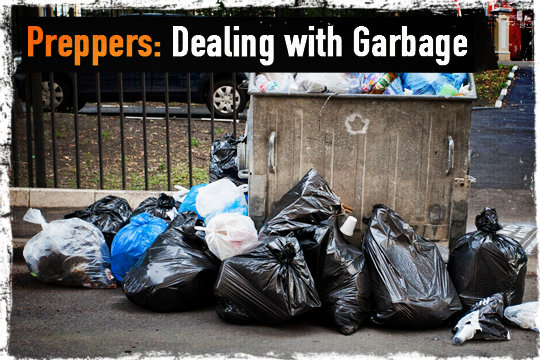
Of course, you would rather talk about long-term food storage, weaponry, solar gadgets and all other gizmos, and hardware large and small, but garbage is important. Garbage cannot be ignored once the SHTF, garbage can kill you, so you need a plan to deal with it once it starts piling up.
According to researchers, the average person generates around 4.5 pounds of waste daily. Obviously, this means some people generate more and some less, so how much do you generate daily. Not human waste but garbage like paper plates, soda cans, plastic bottles, glass jars, food scraps and so on (Clean Air Council, n.d.).
When sanitation workers go on strike what do the streets look like in some of the bigger cities like New York City, for example, and what is the smell like? Remember super storm Sandy and the pictures and videos showing piles of garbage and debris along the streets.
Trash smells and it draws rodents, four legged predators and insects and it breeds deadly bacteria as well, bacteria than can kill you. Garbage is a mess that cannot be ignored, swept under the rug or piled in a corner. Once the SHTF, recycling is probably not on your list of priorities, and no one will be there to haul off your garbage, so what do you do?
Burn, Bury, Bag and Compost
Burning Trash
There are several downsides to burning trash. First, most household trash is not all that combustible, so it would likely require an accelerant to get the job done correctly. In a crisis, you probably do not have excessive amounts of diesel fuel, kerosene or seasoned wood stockpiled, all which would make ideal and relatively safe accelerants. Accelerants are needed to maintain the fire long enough for the garbage to burn completely.
Gasoline and lighter fluids are of course extremely dangerous and you should never use them to create fire. It is not safe to burn plastics, composite or treated wood products, or other products that could potentially emit toxic fumes when burned.
Without an accelerant, you would probably end up with a smoldering pile of garbage in the backyard that would still need to be dealt with. The fire would have to be hot enough for long enough to kill any contaminates and to reduce the material to ash.
The smoke would contaminate any clothes hanging out to dry, so take preventative measures when burning. The smoke would alert anyone that you are there, as well, so from a tactical standpoint burning may be a non-starter in some situations.
Separate what is truly combustible before just piling it all up and trying to light it on fire. You may be able to burn some of it, but not all of it.
Bury Trash
You can bury it but what if the ground is frozen, well if it is that cold then, you can bag the garbage and let it freeze to slow or stop the decomposition. This would prevent bacteria growth and odor for the most part but the cold may not stop rodents and coyotes from prowling around.
Do not bury any trash close to any water source and never dig a garbage pit below the water table level. This also applies for when you are digging latrines or containment pits for outhouses.
You would need a sizable hole, because remember 4.5 pounds per person daily. You should also have some agricultural lime or hydrated lime, which is Calcium Hydroxide on hand to help control odor and bacteria. Simply sprinkle the lime in the garbage pit every day. Lime helps to control odors that are caused by hydrogen sulfide.
Open pits are dangerous, so caution must be used, and measures taken to prevent fall injuries. In most cases, you would want to cover the trash with soil as well as with lime after placing garbage in the pit. Lime is caustic so do not let children handle it and wear gloves and have a dust mask on when handling.
Lime is often times used in outhouses, and open pit latrines. You would use the same lime for garbage pits. Lime inhibits the growth of pathogens by controlling and essentially destroying the environment in which bacteria live. Lime should be a Prepper staple, and it is available in most home and garden stores.
Bagging
You can bag your garbage but in warm weather, bagging would not control the odor for long and animals would soon be into the bags strewing it everywhere unless you had enough barrels to contain and protect it from animals. In some areas of the country, leaving garbage out and accessible can attract dangerous predators.
Plastic bottles and metal cans can be bagged up for repurposing later. In an extended crisis, containers that can store water may become a valuable commodity and aluminum, food storage glass bottles/jars or tin cans be used again at some point as well.
Composting
Most food scraps can be composted in your standard compost bin with the exception of meats, whether they are raw, processed or cooked, bones, human or animal waste. Bury human waste, or have an acceptable latrine/privy established.
Materials you will need stockpiled include quality garbage bags, heavy garbage barrels, shovel and pickax, safety glasses, lime and materials used for accelerants, other than gasoline or lighter fluid, if you plan to burn your garbage. You will likely want heavy gloves, sturdy shoes, dust masks or some type of respirator mask as well.
Clean Air Council. (n.d.). Retrieved 2014, from http://www.cleanair.org/Waste/wasteFacts.html